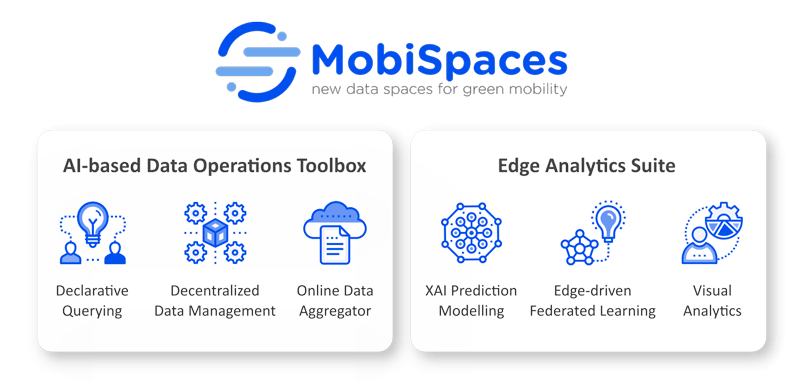by Anita Graser (AIT Austrian Institute of Technology), Christos Doulkeridis (University of Piraeus) and George S. Theodoropoulos (University of Piraeus)
Innovations in the mobility sector are essential to address the climate emergency. Reliable and sustainable mobility services require actionable data. To address these challenges, the recently launched Horizon Europe project, MobiSpaces, develops an innovative, effective, robust and green ecosystem for the entire life cycle of mobility data. This article presents MobiSpaces’ vision and core technological developments.
The mobility data science community has a common goal: to acquire, manage, and generate insights from mobility data. However, there are no integrated solutions that bridge the historical silos separating research and development on moving object data storage and management, spatiotemporal data mining, geographic information science, ubiquitous computing, computational geometry, and related scientific domains. There is also a lack of integrated solutions that bridge between researchers and end users and applications [1].
Over 80% of data has a spatial component. Regardless of this prevalence, spatial data support has been an afterthought in most data management and analysis systems. Consequently, these systems are poorly optimised for spatial data and are far from optimal for handling mobility data. Given the environmental impact of the mobility and transportation sector, as well as the impact of the computing field (with an anticipated CO2 footprint of 8% of global CO2 emissions by 2025) [1], it is clearly essential to address these gaps.
To address these environmental and technical challenges, MobiSpaces [L1] develops a reference data space for the entire life cycle of mobility data and mobility analytics [2]. This mobility data life cycle addresses data governance: security, trustworthiness, interoperability, data sharing and mobility data services. MobiSpaces specifically offers two sets of services, as illustrated in Figure 1: one related to data management and one related to machine learning (ML) and artificial intelligence (AI).

Figure 1: The MobiSpaces mobility data space encompasses both data operations and analytics tools that are tailored to provide support for the specific requirements of mobility data.
The AI-based Data Operations Toolbox comprises efficient data processing operations for both batch and real-time mobility data sources. To provide unified and declarative access to all data, our approach is to provide a structured query language (SQL) interface over heterogeneous data stores, even data stored in raw or minimally processed formats. Moreover, a decentralised data management approach is adopted, which aims to move computations from the cloud towards the edge. For real-time data streams, the online data aggregator component performs in-situ processing and aggregation at the edge, thereby offering high compression rates and reduced communication costs, while also enhancing privacy-preservation, as only aggregated data is moved to the cloud. For example, in maritime settings, online trajectory compression algorithms can be run on edge devices on-board of vessels to analyse the collected data in-situ and reduce the amount of data that has to be transmitted to shore without losing relevant information. This is important since data transfer on the open sea (outside of mobile phone network coverage) is still expensive and bandwidth is limited.
The MobiSpaces Edge Analytics Suite aims to support both descriptive and predictive analytics. The analytics tools include visual analytics capabilities that facilitate the development of data analytics workflows and to interpret the results of the analytics process. In the previously mentioned maritime trajectory compression example, domain experts and data scientists need to work together to fine-tune the workflow to achieve good compression while still retaining the information needed for further analytics that should happen shore-side. Visual analytics capabilities play an important role in this process, because they allow the domain experts to understand the consequences of different compression settings.
MobiSpaces will develop and demonstrate tailored Mobility AI approaches in urban and maritime use cases. (An introduction to the MobiSpaces use cases is available on Youtube [L2].) Advances in edge-driven federated learning, specifically, have the potential to improve privacy by design of mobility solutions as well as to reduce the data transfer and data storage requirements of these solutions [3]. In addition, since trustworthiness and interpretability of AI decisions is essential for the acceptance of AI-based solutions, the Edge Analytics Suite offers an explainable AI (XAI) component to analyse and provide a better understanding of the generated machine learning models.
The vision of green and sustainable data operations can be met by coupling the previously described data technologies with decisions at the infrastructure level. MobiSpaces will develop a solution for resource orchestration that will facilitate intelligent placement of processing tasks at the edge, making use of the data locality of mobility data. By means of in-situ and near-to-the-sources data processing, computation will be offloaded to edge devices, thus minimising communication with the cloud infrastructure, while also reducing the energy consumption of cloud-based operations. In turn, this will result in energy-efficient processing and significant reduction in the carbon footprint of data-intensive operations. Ultimately, the MobiSpaces platform aims for notable energy savings compared to current approaches. To monitor the enhancements, we will also provide a set of green metrics that thoroughly present how much energy is used by each computational edge node in the platform, while taking into account the computational capabilities of each of these nodes, resulting in an accurate depiction of the energy requirements of the whole system.
Links:
[L1] https://mobispaces.eu
[L2] https://youtu.be/9Dbnpjxx0lY
References:
[1] M. Mokbel et al., “Mobility data science (Dagstuhl Seminar 22021)”, Dagstuhl Reports, 12A(1), 1–34, 2022. https://doi.org/10.4230/DagRep.12.1.1
[2] C. Doulkeridis, et al., “A survey on big data processing frameworks for mobility analytics”, SIGMOD Rec. 50(2): 18-29, 2021. https://doi.org/10.1145/3484622.3484626
[3] A. Graser, C. Heistracher and V. Pruckovskaja, “On the role of spatial data science for federated learning”, in Spatial Data Science Symposium (SDSS2022), 2022. https://escholarship.org/uc/item/7mg5655h
Please contact:
Anita Graser, AIT Austrian Institute of Technology, Austria
Christos Doulkeridis , University of Piraeus, Department of Digital Systems










